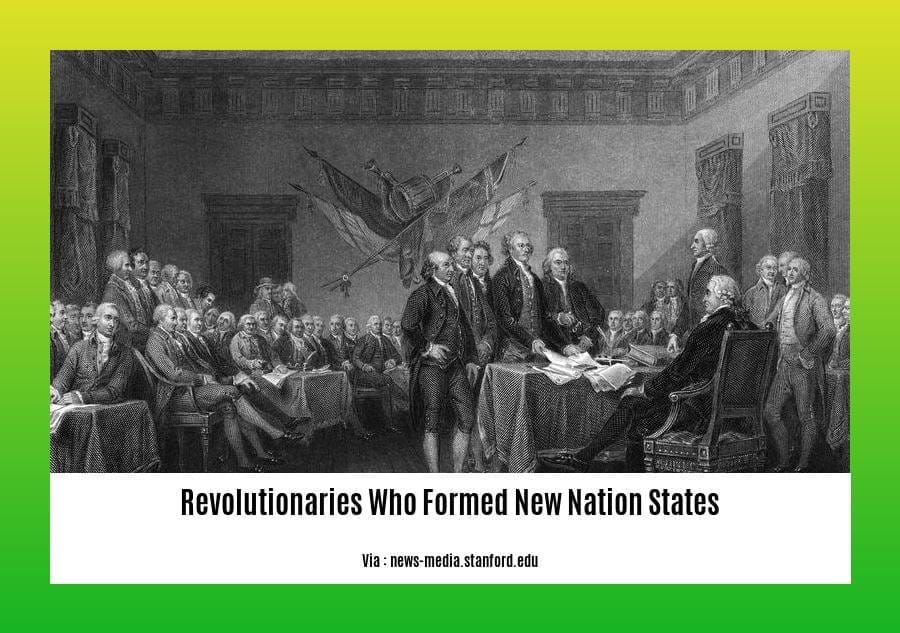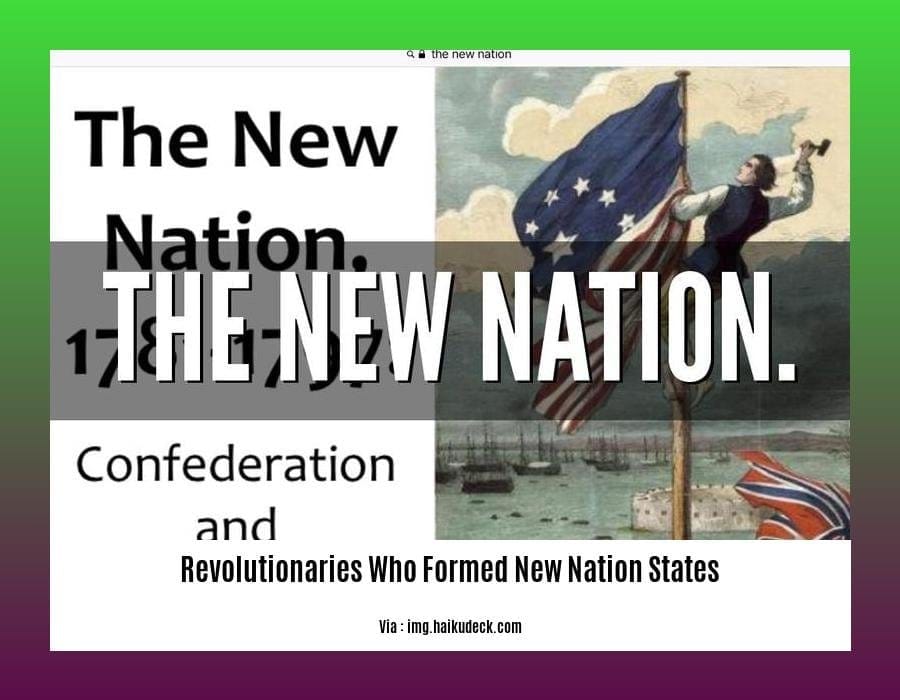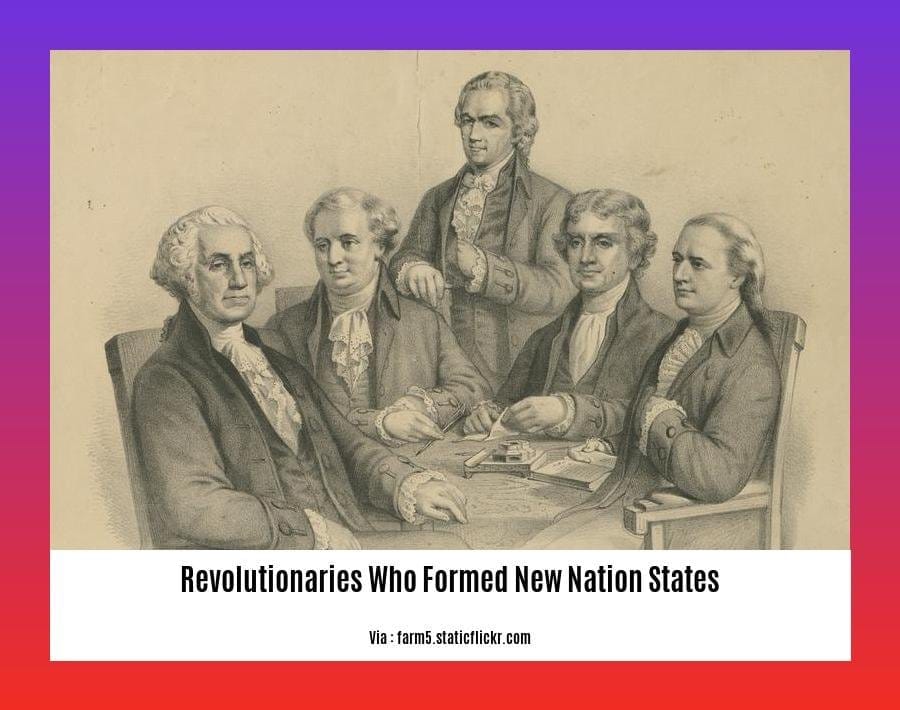Embark on an extraordinary historical adventure with “The Rise of Revolutionaries: Founding New Nation-States Through Historical Struggles.” Delve into the inspiring journeys of those who dared to challenge empires and establish new nations in the American Revolution, Serbian Revolution, Haitian Revolution, and Latin American Wars of Independence. Experience the struggles, sacrifices, and triumphs that shaped the destinies of these emerging nation-states.
Key Takeaways:

- American self-governance: Articles of Confederation experimented with self-rule after independence.
- Emerging American identity: A distinct American culture and identity developed, separate from colonial influences.
- Western expansion: Uncertainty about the vast lands westwards led to the Lewis and Clark expedition.
- Republicanism: The American Revolution championed republicanism, inspired by the Roman Republic, as an alternative to monarchy.
Revolutionaries Who Formed New Nation-States
Crafting New Governments Through Revolutionary Struggles:
Nation-states are the dominant form of political organization in the modern world, but the formation of these states has often been a tumultuous journey marked by revolutionary struggles. These revolutionaries who formed new nation-states often faced overwhelming odds as they sought to break free from existing power structures and establish new societies based on their own ideals. Their stories serve as a testament to the indomitable spirit of those who dare to dream of a better future.
The American Revolutionaries are perhaps the most well-known revolutionaries who formed a new nation-state. Inspired by Enlightenment ideals of liberty and self-governance, they successfully fought for independence from Great Britain and established a new nation based on democratic principles. The American Revolution became a model for countless other revolutions around the world, inspiring people to fight for their own freedom and self-determination.
The Evolving Landscape:
The 18th and 19th centuries witnessed a surge in revolutionary movements as people across the globe sought to overthrow oppressive regimes and establish new nations based on their own values. The French Revolution, the Haitian Revolution, and the revolutions in Latin America are just a few examples of the many successful revolutionaries who formed new nation-states.
Challenges and Triumphs:
The path of a revolutionary is never easy. These revolutionaries who formed new nation-states faced numerous challenges, including:
- Resistance from existing power structures
- Lack of resources and support
- Divisions within their own ranks
- International pressure
Despite these challenges, many revolutionary movements succeeded in their goals. The revolutionaries who formed new nation-states** often had a clear vision for the future, a deep commitment to their cause, and a willingness to make great sacrifices. Their stories inspire us to believe that anything is possible if we dare to dream and fight for what we believe in.
Nation-building has been the aim of many revolutionary founders of new countries, not all have been as successful, but a few have shaped the very face of the nations they are responsible for creating. These men and women are often referred to as nation-building revolutionary leaders, and they have left a lasting legacy on the world.
Revolutionary statesmen behind new nations, they are often remembered for their courage and determination in the face of adversity. They have also been praised for their vision and their ability to inspire others to follow their dreams. The legacy of these individuals continues to inspire people today, and they serve as a reminder that anything is possible if you have the courage to dream big.
Haitian Revolution (1791–1804)
The Haitian Revolution (1791–1804) marked a colossal chapter in the annals of history as the Haitian slaves rose up against their French colonizers, ultimately establishing the first nation founded by formerly enslaved people. This epochal struggle left an indelible mark on the global landscape, inspiring movements for freedom and equality worldwide.
In this article, we’ll delve into the pivotal events and figures of the Haitian Revolution, exploring the profound impact it had on the birth of a new nation and the dawn of a transformative era.
Key Takeaways:
- The Haitian Revolution (1791–1804) was a protracted struggle between Haitian slaves, French colonists, and foreign armies.
- The revolution’s primary objective was to secure independence from French rule.
- The Haitian Revolution resulted in Haiti becoming the first nation established by former slaves.
- Jean-Jacques Dessalines, a former slave, played a pivotal role in leading the revolution and declaring Haiti’s independence.
- Toussaint Louverture, another prominent figure, made significant contributions to the revolution’s early stages.
Like other successful revolutions in history, the Haitian Revolution (1791–1804) serves as a testament to the unwavering spirit of those seeking freedom and self-determination. It stands as a beacon of hope and inspiration for those who dare to challenge oppression and forge a new path for their people.
Most Relevant URL Source:
Latin American Wars of Independence (1808–1833)
Rise of Latin American Heroes
In Latin America, the battle for independence was nothing short of extraordinary, with brave men leading the charge to liberate nations from colonial rule. Miguel Hidalgo of Mexico, José de San Martin of Argentina, Chile, and Peru, and Simón Bolívar of Colombia, Venezuela, Ecuador, and Peru stand out as beacons of courage and determination. Their sacrifices paved the way for a new era of self-governance and nationhood.
Victory for the Oppressed
The Haitian Revolution remains a shining example of the indomitable spirit of the oppressed. Led by Toussaint Louverture and Jean-Jacques Dessalines, enslaved people fought relentlessly against French colonizers. Their struggle culminated in Haiti becoming the first free Black republic in the world, inspiring countless others to fight for their liberation.
Key Takeaways:
- The Latin American Wars of Independence were a transformative period marked by fierce battles and heroic leaders who fought for the freedom of their people.
- The efforts of Miguel Hidalgo, José de San Martin, Simón Bolívar, and Toussaint Louverture played a crucial role in shaping the political landscape of the region.
- The Haitian Revolution stands as a testament to the power of perseverance and the indomitable spirit of those fighting for justice.
Most Relevant URL Sources:
- Latin American Revolutionaries

FAQ
Q1: What was the significance of the Articles of Confederation for the American Revolution?
A1: The Articles of Confederation served as the first constitution for the newly independent United States, establishing a loose confederation of states. It provided a framework for self-government and played a crucial role in the early stages of nation-building.
Q2: How did the American Revolution influence the development of republicanism?
A2: The American Revolution promoted republicanism as an alternative to monarchy. Inspired by the Roman Republic, the revolutionaries established a system of government based on the principles of popular sovereignty, limited government, and the rule of law.
Q3: Who were some of the key leaders in the Latin American Wars of Independence?
A3: Prominent leaders in the Latin American Wars of Independence included Toussaint L’Ouverture of Haiti, Miguel Hidalgo of Mexico, José de San Martin of Argentina, Chile, and Peru, and Simón Bolívar of Colombia, Venezuela, Ecuador, and Peru.
Q4: What was the impact of the Haitian Revolution?
A4: The Haitian Revolution resulted in the overthrow of French colonial rule and the establishment of Haiti as the first nation founded by former slaves. It had a profound impact on the abolitionist movement and inspired other revolutions in the Americas.
Q5: How did the Serbian Revolution contribute to the rise of nationalism in the Balkans?
A5: The Serbian Revolution played a pivotal role in the development of Serbian national identity and laid the foundation for the establishment of an independent Serbian state. It sparked a sense of national unity and pride, inspiring subsequent nationalist movements in the region.
- China II Review: Delicious Food & Speedy Service - April 17, 2025
- Understand Virginia’s Flag: History & Debate - April 17, 2025
- Explore Long Island’s Map: Unique Regions & Insights - April 17, 2025
















